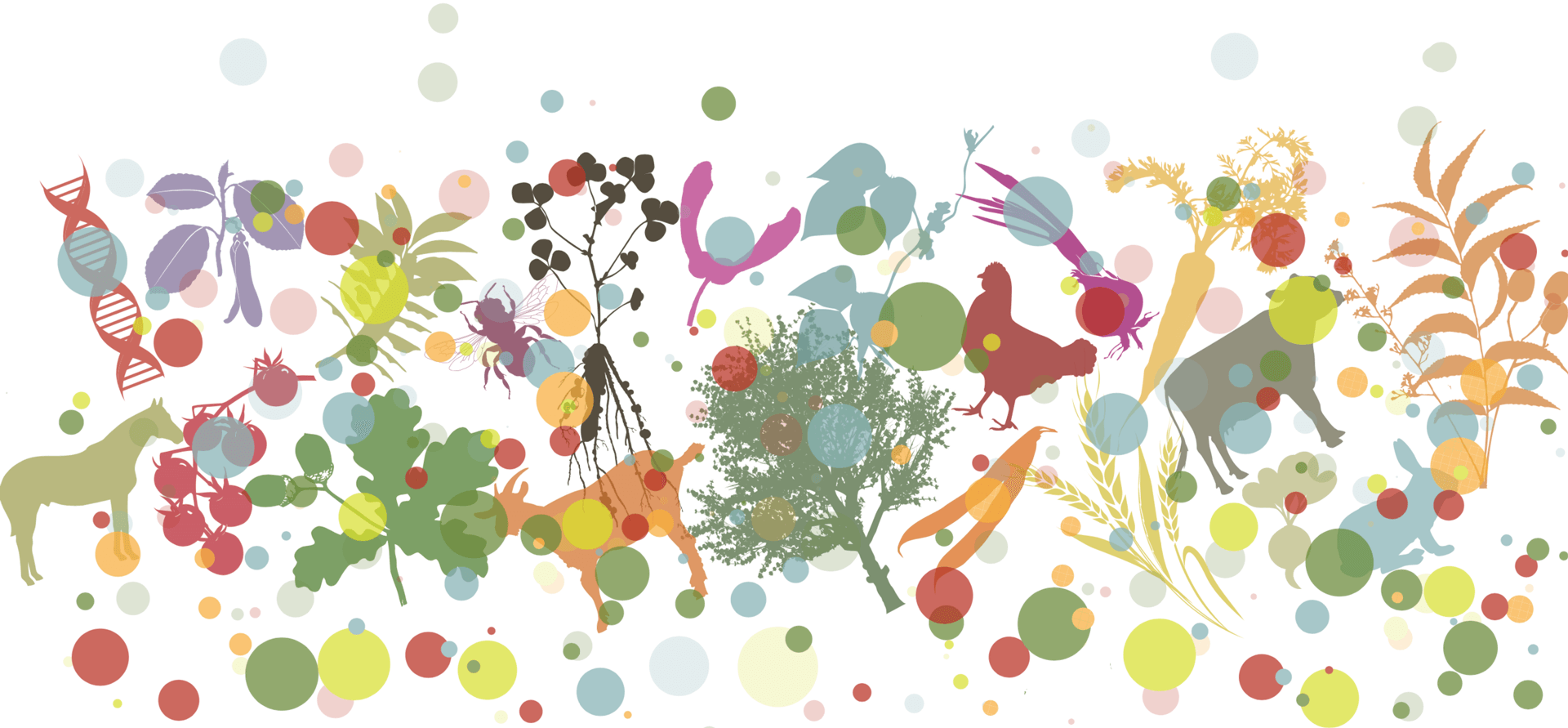Phenotypic characterization of sheep populations in Tahtay Maichew district, Northern Ethiopia
Main Article Content
Abstract
Eighteen quantitative measurements and fourteen qualitative characteristics taken from 306 adult sheep (57 rams and 249 ewes) were used to characterize sheep populations of district, Ethiopia. Most traits showed significant variation by zone, sex and age groups with higher values generally recorded for rams as compared to ewes. Middle age group animals displayed highest values for several traits, reflecting the optimal production age. zone affected ewes more than rams. The highland sheep height at withers, widest shoulder points and longest hair, indicative of adaptation to their environment. Qualitative characteristics of the studied sheep populations such as tail shape, plain coat color pattern, skin, hairy fiber and the absence of horn, toggle, ruff and beard suggest that they constitute a previously sheep breed. Tan coat color differentiated high and midland sheep from lowland sheep where white and brown colors were dominant. Canon bone length, height at withers and tail length were the three most important variables used in discriminating the sheep populations. On average 66% of the animals could be classified into their respective zone. Our data suggest that highland sheep populations are distantly related to lowland sheep, while midland sheep are more closely related to lowland sheep. It can be concluded that breeding programs specific to each zone need to be designed for sustainable utilization and conservation of the studied sheep populations. Furthermore, molecular based studies might allow further characterization of Ethiopian sheep breeds.
Article Details
Authors retain copyright of the articles published in Genetic Resources and grant the journal right of first publication with open access. All articles published in Genetic Resource are licensed under Creative Commons Attribution 4.0 International License (CC BY 4.0) that allows others to download, share and adapt the work for commercial and non-commercial purposes as long as proper attribution to the original article is given. Genetic Resources permits and encourages authors to post items submitted to the journal (including the publisher's final layout) on personal websites or institutional repositories after acceptance and/or publication, while providing bibliographic details that credit their publication in Genetic Resources.
Atsbeha, G et al. (2015). “Floristic composition of herbaceous flowering plant species in Lalay and Tahtay Michew Districts, Central Zone of Tigray, Ethiopia”. African Journal of Ecology and Ecosystems 2(6), pp. 159–169.
Baneh, H and S H Hafezian (2009). “Effect of environmental factor on growth traits in Ghezel sheep”. African Journal of Biotechnology 8, pp. 2903–2907. URL: https://www.ajol.info/index.php/ajb/article/view/60943.
Bimerow, T et al. (2011). “Morphological Characteristics of Farta Sheep in Amhara Region, Ethiopia”. Online Journal of Animal and Feed Research 1(6), pp. 299–305.
Central Statistical Agency (2005). “Ethiopian agricultural sample survey 2012/2013 (2005 E.C.)” In: Report on livestock and livestock characteristics. Vol. II. Addis Ababa, Ethiopia: Central Statistical Agency.
Central Statistical Agency (2018). “Ethiopian agricultural sample survey 2017/18 (2010 E.C.)” In: Report on livestock and livestock characteristics. Vol. II. Addis Ababa, Ethiopia: Central Statistical Agency.
Degen, A. A. (2007). “Sheep and goat milk in pastoral societies”. Small Ruminant Research 68(1-2), pp. 7–19. DOI: 10.1016/j.smallrumres.2006.09.020. URL: https://dx.doi.org/10.1016/j.smallrumres.2006.09.020.
Devendra, C and G B Mcleroy (1982). Goat and sheep production in the tropics. Intermediate tropical agriculture series. London: Longman.
EBI (2016). Ethiopian National Strategy and Plan of Action for conservation and utilization of Animal Genetic Resources. Addis Ababa, Ethiopia: Ethiopian Biodiversity Institute, pp. 114–114. URL: https://www.ebi.gov.et/wp-content/uploads/2013/01/Final%20ENSAP_final_submitted%20(1).pdf.
Edea, Z et al. (2010). “Morphological characterization of Bonga and Horro indigenous sheep breeds under smallholder conditions in Ethiopia”. Ethiopian Journal of Animal Production 9(1), pp. 117–133.
FAO (2012). Phenotypic characterization of Animal Genetic Resources. Rome, Italy. URL: www.fao.org/docrep/015/i2686e/i2686e00.pdf.
Gebreyowhens, W and Y Tesfay (2016). “Morphological Characterization of Indigenous Highland Sheep Population of Tigray, Northern Ethiopia”. Journal of Natural Sciences Research 6(1), pp. 96–104. URL: https://www.iiste.org/Journals/index.php/JNSR/article/view/28281/0.
Getachew, T et al. (2009). “Morphological characters and body weight of Menz and Afar sheep within their production system”. Ethiopian Journal of Animal Production 9(1), pp. 99–115.
Gizaw, S. et al. (2008). “Indigenous sheep resources of Ethiopia: types, production systems and farmers preferences”. Animal Genetic Resources Information 43, pp. 25–39. DOI: 10.1017/s1014233900002704. URL: https://dx.doi.org/10.1017/s1014233900002704.
Hayelom, M, S Abegaz, and Y Mekasha (2014). “Within Breed Phenotypic Diversity of Sokota/Tigray Sheep in Three Selected Zones of Tigray, Northern Ethiopia”. Journal of Biology Agriculture and Healthcare 4(17), pp. 148–157. URL: https://www.iiste.org/Journals/index.php/JBAH/article/view/15182.
Melaku, S et al. (2019). “Phenotypic characterization of Simien sheep in Simien Mountain Region”. Ethiopia. International Journal of Agriculture and Biosciences 8(4), pp. 178–185. URL: http://www.ijagbio.com/volume-8-no-4-2019/.
Mengistie, T et al. (2010). “Traditional management systems and linear body measurements of Washera sheep in the western highlands of the Amhara National Regional State, Ethiopia”. Livestock Research for Rural Development 22(169). URL: http://www.lrrd.org/lrrd22/9/taye22169.htm.
Michael, A, K Kefelegn, and M Yoseph (2016). “Phenotypic Characterization of Indigenous Sheep Types in Northern Ethiopia”. Journal of Natural Sciences Research 6(15), pp. 16–27. URL: https://iiste.org/Journals/index.php/JNSR/article/view/32220/33107.
Misra, A K and K Singh (2002). “Effect of water deprivation on dry matter intake, nutrient utilization and metabolic water production in goats under semi-arid zones of India”. Small Ruminant Research 46, pp. 159–165. DOI: https://doi.org/10.1016/S0921-4488(02)00187-6.
Mustefa, A et al. (2019). “Growth performance of Boer goats and their F1 and F2 crosses and backcrosses with Central Highland goats in Ethiopia”. Livestock Research for Rural Development 31(6), p. 89. URL: http://www.lrrd.org/lrrd31/6/amine31089.html.
Rensch, B (1950). “Die Abhängigkeit der relativen Sexualdifferenz von der Körpergröße”. Bonner Zoologische Beitrage 1, pp. 58–69.
SAS Institute (2002). Statistical Analysis Software (SAS). Cary, NC, USA. URL: https://www.sas.com/en_us/software/stat.html.
Tajebe, S, S K Gangwar, and K Kebede (2011). “Performance and Physical Body Measurement of Abergele Sheep Breed in Traditional Management System of Tigray Regional State, Northern Ethiopia”. International Journal of Science and Nature 2(2), pp. 225–230. URL: https://hdl.handle.net/10568/70955.
Worku, A (2018). Morphometrical Characterization and Traditional Breeding Objectives of Native Sheep Reared in East Shoa and West Arsi Zone of Oromia Regional State. M.Sc. thesis, Hawassa University, Hawassa, Ethiopia.







 This journal has been conceived as part of the
This journal has been conceived as part of the